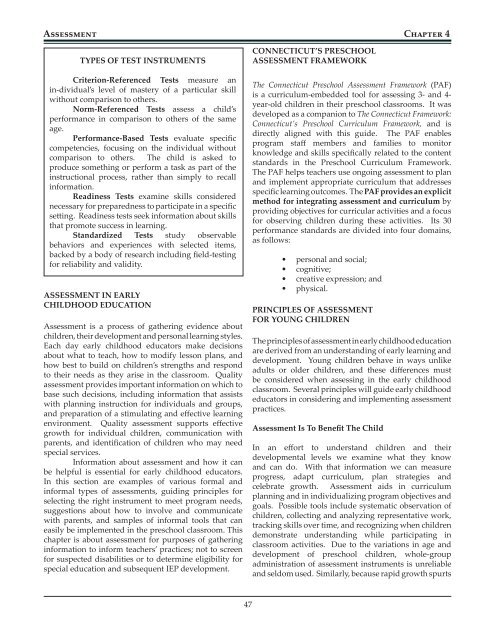Early Childhood - Connecticut State Department of Education
Early Childhood - Connecticut State Department of Education
Early Childhood - Connecticut State Department of Education
You also want an ePaper? Increase the reach of your titles
YUMPU automatically turns print PDFs into web optimized ePapers that Google loves.
Assessment Chapter 4<br />
TYPES OF TEST INSTRUMENTS<br />
Criterion-Referenced Tests measure an<br />
in-dividual’s level <strong>of</strong> mastery <strong>of</strong> a particular skill<br />
without comparison to others.<br />
Norm-Referenced Tests assess a child’s<br />
performance in comparison to others <strong>of</strong> the same<br />
age.<br />
Performance-Based Tests evaluate specific<br />
competencies, focusing on the individual without<br />
comparison to others. The child is asked to<br />
produce something or perform a task as part <strong>of</strong> the<br />
instructional process, rather than simply to recall<br />
information.<br />
Readiness Tests examine skills considered<br />
necessary for preparedness to participate in a specific<br />
setting. Readiness tests seek information about skills<br />
that promote success in learning.<br />
Standardized Tests study observable<br />
behaviors and experiences with selected items,<br />
backed by a body <strong>of</strong> research including field-testing<br />
for reliability and validity.<br />
ASSESSMENT IN EARLY<br />
CHILDHOOD EDUCATION<br />
Assessment is a process <strong>of</strong> gathering evidence about<br />
children, their development and personal learning styles.<br />
Each day early childhood educators make decisions<br />
about what to teach, how to modify lesson plans, and<br />
how best to build on children’s strengths and respond<br />
to their needs as they arise in the classroom. Quality<br />
assessment provides important information on which to<br />
base such decisions, including information that assists<br />
with planning instruction for individuals and groups,<br />
and preparation <strong>of</strong> a stimulating and effective learning<br />
environment. Quality assessment supports effective<br />
growth for individual children, communication with<br />
parents, and identification <strong>of</strong> children who may need<br />
special services.<br />
Information about assessment and how it can<br />
be helpful is essential for early childhood educators.<br />
In this section are examples <strong>of</strong> various formal and<br />
informal types <strong>of</strong> assessments, guiding principles for<br />
selecting the right instrument to meet program needs,<br />
suggestions about how to involve and communicate<br />
with parents, and samples <strong>of</strong> informal tools that can<br />
easily be implemented in the preschool classroom. This<br />
chapter is about assessment for purposes <strong>of</strong> gathering<br />
information to inform teachers’ practices; not to screen<br />
for suspected disabilities or to determine eligibility for<br />
special education and subsequent IEP development.<br />
47<br />
CONNECTICUT’S PRESCHOOL<br />
ASSESSMENT FRAMEWORK<br />
The <strong>Connecticut</strong> Preschool Assessment Framework (PAF)<br />
is a curriculum-embedded tool for assessing 3- and 4year-old<br />
children in their preschool classrooms. It was<br />
developed as a companion to The <strong>Connecticut</strong> Framework:<br />
<strong>Connecticut</strong>’s Preschool Curriculum Framework, and is<br />
directly aligned with this guide. The PAF enables<br />
program staff members and families to monitor<br />
knowledge and skills specifically related to the content<br />
standards in the Preschool Curriculum Framework.<br />
The PAF helps teachers use ongoing assessment to plan<br />
and implement appropriate curriculum that addresses<br />
specific learning outcomes. The PAF provides an explicit<br />
method for integrating assessment and curriculum by<br />
providing objectives for curricular activities and a focus<br />
for observing children during these activities. Its 30<br />
performance standards are divided into four domains,<br />
as follows:<br />
• personal and social;<br />
• cognitive;<br />
• creative expression; and<br />
• physical.<br />
PRINCIPLES OF ASSESSMENT<br />
FOR YOUNG CHILDREN<br />
The principles <strong>of</strong> assessment in early childhood education<br />
are derived from an understanding <strong>of</strong> early learning and<br />
development. Young children behave in ways unlike<br />
adults or older children, and these differences must<br />
be considered when assessing in the early childhood<br />
classroom. Several principles will guide early childhood<br />
educators in considering and implementing assessment<br />
practices.<br />
Assessment Is To Benefit The Child<br />
In an effort to understand children and their<br />
developmental levels we examine what they know<br />
and can do. With that information we can measure<br />
progress, adapt curriculum, plan strategies and<br />
celebrate growth. Assessment aids in curriculum<br />
planning and in individualizing program objectives and<br />
goals. Possible tools include systematic observation <strong>of</strong><br />
children, collecting and analyzing representative work,<br />
tracking skills over time, and recognizing when children<br />
demonstrate understanding while participating in<br />
classroom activities. Due to the variations in age and<br />
development <strong>of</strong> preschool children, whole-group<br />
administration <strong>of</strong> assessment instruments is unreliable<br />
and seldom used. Similarly, because rapid growth spurts

















